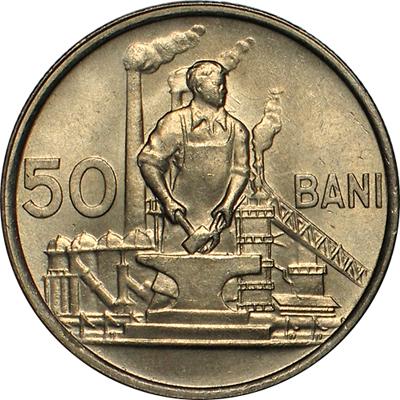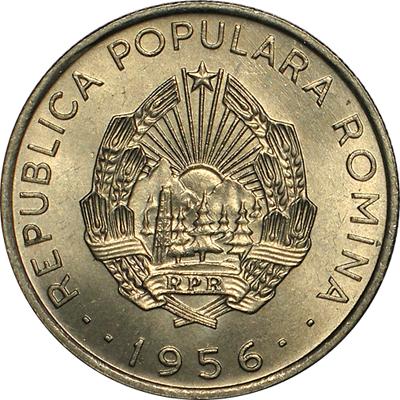
|
50 bani 1955, 1956 |
|

| 
|
|
25 mm diameter, 4.55 g, copper-nickel alloy, grained edge denomination "50 BANI" and a worker standing, with rolled up sleeves, holding a part on anvil with tongs (left hand), holding hammer in the right hand; industrial background (smoke flues, conveyor belt, silos) | Inscription "REPUBLICA POPULARA ROMĪNA" meaning "ROMANIAN PEOPLE'S REPUBLIC", year 1956 flanked on either sides by a pair of squares, Romanian coat of arms
Mintage 1955: 16.700.000 coins Mintage 1956: 11.400.000 coins |
These coins were struck at Bucharest Mint. It interesting to observe that ROMĪNA is written with "Ī", a rare case of using diacritical signs on Romanian coins. The presence of the "hat on i" from "Ī" is also an inconsequence, because POPULARA is written with A instead of Ć (and, of course, ROMĪNA instead of ROMĪNĆ).
In the monograph Monede ŗi bancnote romāneŗti (Buzdugan, Luchian and Oprescu, 1977) these coins are presumed to be made from nickel. They seem to be made from the same alloy as the 10 bani coins in the same series, which are declared to be cupronickel. It is obvious that these coins cannot be made from nickel, because this metal is ferromagnetic and the coins of this series are not attracted by the magnet.
The coins certain to have been made of nickel as the 50 and 100 lei 1936-1938 or the Canadian cents (e.g. 5 cents struck between 1955 and 1981 or 10 and 25 cents struck after 1968) are strongly attracted by the magnet. The Romanian cupronickel (75% copper and 25% nickel) coins, e.g. the 5, 10 and 20 bani 1905 and 1906 or the 1 and 2 lei 1924 are not attracted by the magnet.
The design is practically identical to the 20 lei of 1951, so we assume they have the same engraver, Haralamb Ionescu.
The pictures of 50 bani 1956 are present on Romanian coins through the kind permission of an anonymous donor.
|
Back to selection page!
|